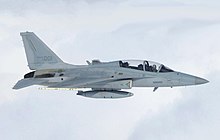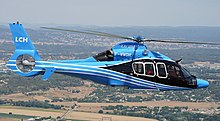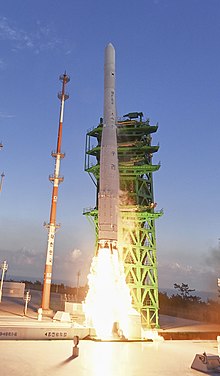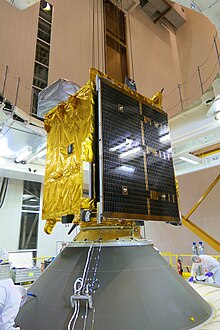Korea Aerospace Industries
 | |
Native name | 한국항공우주산업주식회사 |
|---|---|
| Company type | Public |
| KRX: 047810 | |
| Industry | |
| Predecessors | [1] |
| Founded | 1 October 1999[2] |
| Headquarters | 78, Gongdanro 1-ro, Sanam-myeon, , |
Area served | Worldwide |
Key people |
|
| Products | |
| Revenue | |
| Total assets | |
| Total equity | |
| Owner |
|
Number of employees | 5,222[4] (March, 2024) |
| Subsidiaries |
|
| Website | Official website in English Official website in Korean |
Korea Aerospace Industries, Ltd. (KAI; Korean: 한국항공우주산업; Hanja: 韓國航空宇宙産業; RR: Hanguk Hanggonguju Saneop) is a South Korean aerospace and defense company. It was originally established as a joint venture of Daewoo Heavy Industries' aerospace division, Samsung Aerospace, and Hyundai Space and Aircraft.[1][6] During 1999, KAI became more independent of its founding members, acquiring their aerospace interests at the behest of the South Korean government following the financial troubles of these companies that had resulted from the 1997 Asian financial crisis.[7]
KAI has developed various aerospace products, including the Korean Space Launch Vehicle-II (KSLV-II) and various satellites. It has been involved in the production of several foreign-designed aircraft via licensing arrangements, such as the MBB/Kawasaki BK 117, MBB Bo-105 KLH, and the KF-16. KAI has also developed and produced its own aircraft designs, including the KT-1 Woongbi and T-50 Golden Eagle training aircraft, the KC-100 Naraon general aviation aircraft, and the KUH-1 Surion utility helicopter. Both the company's headquarters and several key manufacturing facilities are located in Sacheon, South Gyeongsang Province.
Projects
[edit]









KAI was involved in the production of the first indigenously developed South Korean aircraft, the KT-1 Woongbi; it was developed under the KTX program, which had been launched during 1988 on behalf of the Republic of Korea Air Force (ROKAF) to develop an indigenously designed trainer aircraft. It was a joint effort between KAI and government body Agency for Defense Development (ADD); the latter was responsible for overseeing the project, while the former performed the detailed design work as well as the majority of manufacturing activity.[8] During 2002, KAI revealed that they were working on the production of an upgraded and armed version of the KT-1, designated KO-1, which was intended to be used in the forward air control and counter-insurgency (COIN) roles. Development was conducted in cooperation with the ADD and had been undertaken in response to an existing RKAF requirement for 20-40 aircraft.[9]
During June 2006, KAI and Eurocopter won a ₩1.3 trillion (equivalent to ₩1.67 trillion or US$1.48 billion in 2017)[10] research and development contract for the Korea Helicopter Project - Korea Utility Helicopter (KHP-KUH) from the Defense Acquisition Program Administration (DAPA) to start the project. The development of the rotorcraft, the KUH-1 Surion, was funded 84% by the South Korean government and 16% by KAI and Eurocopter.[11][12] At the time, it was the biggest South Korean defense contract to be issued to a non-American defense company.[13] In January 2011, Eurocopter and KAI established a joint venture, KAI-EC, for the purposes of marketing the Surion and handling export sales; at the time, it was envisioned that 250-300 units would be sold worldwide by 2021.[14] In December 2012, deliveries of the first Surion model formally commenced.[15] In February 2013, low temperature testing in Alaska, United States, was completed, leading to development of the KUH-1 Surion being formally recognized as completed in the following month.[15] The Surion served as the basis for a navalised derivative, the Korean Naval Helicopter (KNH); by 2011, the KNH had entered into the development stage; work was being performed on the project by a partnership between KAI, Eurocopter, and Elbit Systems.[14] In January 2016, following completion of development work on the amphibious variant of the Surion, it was announced that this variant had been cleared to enter production later that year.[16][17]
Keen to beak into the civilian market and reduce its reliance on government projects, KAI formally launched development of the KC-100 Naraon general aviation aircraft during 2008.[18] While largely conventional in its basic configuration, use of composite materials and the adoption of cutting-edge technologies were intended to allow it to be 10% more fuel efficient than existing rivals.[19][20][21] The flight test program was completed successfully on 22 March 2013, the aircraft's type certificate being received shortly thereafter. During the 2010s, KAI commenced development of a military trainer variant, designated KT-100, for the ROKAF; the first aircraft of this model first flew during 2015.[22] Once delivered, the KT-100 fleet will replace the 20 Ilyushin Il-103 aircraft currently stationed at the ROKAF's academy for training student pilots.[23]
In 2008, KAI studied a 60-seat KRJ regional jet: a T-tail, four-abreast aircraft able to be stretched to 100 seats, similar to the Bombardier CRJ.[24] Two years later, the company was reportedly still considering launching a 90-seat turboprop; it was then believed that an announcement could occur as early as 2011.[25] In October 2012, a joint development deal between Bombardier Aerospace and a government-led South Korean consortium was revealed, to develop a 90-seater turboprop regional airliner, targeting a 2019 launch date. The consortium would include both KAI and Korean Air Lines.[26] Despite this announcement, KAI continued to study the prospective 90-seat regional airliner for several more years.[24]
During 2019, it was announced that KAI is to manufacture the wings of the Gulfstream G280 business jet on behalf of Israeli manufacturer IAI, taking over from the Triumph Group; the company is contracted 300 sets until 2030 for $529 million, at a new factory at Goseong, 30 km (20 mi) from its Sacheon main plant.[24] In the long term, the company reportedly has ambitions to license-produce a civil aircraft from 2023; it also seeks to develop a 50-70 seat regional airliner, powered either by turboprop or turbofan engines. The latter is set to complete exploratory development by 2022; a 2030 introduction date has been set.[24]
Products
[edit]Fixed-wing aircraft
[edit]- KAI KT-1 Woongbi (2000) - turboprop engine basic trainer[27]
- KAI T-50 Golden Eagle (2005) - supersonic advanced jet trainer[28]
- KAI KC-100 Naraon[29] (2011) - four-seat, single piston engine general aviation aircraft[30]
- KAI FA-50 Fighting Eagle (2013) - supersonic light combat aircraft[31]
- KAI KT-100 (2015) - military piston-engined basic trainer[32]
- KAI KF-21 Boramae[33] (development) - supersonic multirole fighter[34]
- KAI MC-X (research and development) - advanced military transport aircraft to be developed with the United Arab Emirates[35][36][37]
Helicopters
[edit]- KAI KUH-1 Surion (2013) - medium transport helicopter[38]
- KAI LAH[39] - military armed helicopter[40]
- KAI LCH - civil transport helicopter[41]
Unmanned aerial vehicles
[edit]- KAI NCUAV (development) - next generation corps level reconnaissance UAV for South Korean Army[43]
Space launch vehicles
[edit]- Korean Space Launch Vehicle-II (2021) - The Korean Space Launch Vehicle-II (KSLV-II) has been designed to generate a combined thrust of 300 tons by tying in parallel four 75 ton-class liquid fuel-powered engines. KSLV 2 is the launcher earmarked for the spacecraft that South Korea proposes to send to the moon by 2022. A lunar lander is supposed to follow in 2030.[44][45][46]
Satellites
[edit]Electro-optical satellites
[edit]Synthetic aperture radar satellites
[edit]Electro-optical/infrared satellites
[edit]Geostationary satellites
[edit]Small satellites
[edit]Training systems
[edit]- T/TA-50 training system[52]
- FA-50 training system[52]
- KUH training system[52]
- P-3CK simulator[52]
- KF-16 simulator[52]
- KT-1 simulator[52]
- MUH simulator[52]
- KSS-III (Jangbogo-III) submarine simulator[52]
- VR device[52]
- AI training system[52]
Co-development
[edit]- Bell 427 helicopter, designed and manufactured by Bell Helicopter and Samsung Aerospace Industries.
- Bell 429 helicopter, designed and manufactured by Bell Helicopter and Samsung Aerospace Industries.
Licensed production
[edit]- MBB/Kawasaki BK 117: Hyundai Space and Aircraft Company in 1989 assembled a BK-117.
- MBB Bo-105 KLH (1989): Daewoo Heavy Industries (aerospace division) license-produced combat version of CBS-5.
- KF-16, (1991): Samsung Aerospace produced 140 F-16 C/D Block 52 fighters under license from Lockheed Martin in the 1990s.[53]
Upgrade and Modification
[edit]Future projects
[edit]- KAI Midsize Turboprop Passenger Plane - on joint development of a 90-seat turboprop plane by 2019.[55]
See also
[edit]References
[edit]- ^ a b "Articles of Incorporation" (PDF). Korea Aerospace Industries. 29 March 2019. Archived from the original (PDF) on 5 January 2024. Retrieved 5 January 2024. p. 22–27
- ^ "About KAI". Korea Aerospace Industries. Archived from the original on 31 December 2023. Retrieved 31 December 2023.
- ^ a b c d e f g h i j "KOREA AEROSPACE 047810". FnGuide. December 2023. Archived from the original on 7 August 2024. Retrieved 7 August 2024.
- ^ "한국항공우주산업(주)". Job Korea. 31 March 2024. Archived from the original on 7 August 2024. Retrieved 7 August 2024.
- ^ "Commercial Aircraft MRO". Korea Aerospace Industries. Archived from the original on 2 January 2024. Retrieved 2 January 2024.
- ^ Lee Duk-ju (28 September 2012). "상업용 민간 무인항공기 보급 기반 구축 기획 최종보고서". Ministry of Land, Transport and Maritime Affairs. Archived from the original on 30 December 2023. Retrieved 30 December 2023. p. 97
- ^ Jaewoo Kim, Sangryul Shim (31 August 2020). "A Case Study on the Evolutionary Development of U.S Unmanned Aerial Vehicles (UAVs): Focusing on Tactical/Strategic Fixed-wing UAVs". Journal of Advances in Military Studies. Archived from the original on 29 December 2023. Retrieved 29 December 2023. p. 7
- ^ Doyle, Andrew. "State body to lead South Korean helicopter effort." Archived 17 June 2019 at the Wayback Machine Flight International, 13 August 2002.
- ^ "KAI arms trainer for new role." Archived 17 June 2019 at the Wayback Machine Flight International, 5 March 2002.
- ^ 1906 to 1911: Williamson J. (1999), Nominal Wage, Cost of Living, Real Wage and Land Rent Data for Korea 1906-1939 1912 to 1939: Mizoguchi, T. (1972). Consumer Prices and Real Wages in Taiwan and Korea Under Japanese Rule. Hitotsubashi Journal of Economics, 13(1), 40-56. Retrieved May 21, 2021. Afterwards, consumer price index from Statistics Korea. Consumer Price Index by year. Retrieved 3 April 2018
- ^ "한국형 기동헬기 실물모형 공개". The Dong-a Ilbo. 15 October 2007. Archived from the original on 20 August 2014.
- ^ Donald, David. "Korea's Surion Helicopter Flies." AIN Online, 15 March 2010.
- ^ "Local helicopter manufacturing is expensive flop." Korea JoongAng Daily, 22 December 2014.
- ^ a b "Eurocopter reinforces its commitment to strengthen the Republic of Korea's aerospace industry, and highlights the Surion and its naval derivative." Vertical, 19 October 2011.
- ^ a b "History." KAI, Retrieved: 23 June 2016.
- ^ Perrett, Bradley."Marines Version OF KAI Surion Ready For Production." Aviation Week, 5 January 2016.
- ^ Maass, Ryan. "KAI completes Surion-variant helicopter development." United Press International, 29 December 2015.
- ^ Chan-Jo, Kim. "Flight Test for Type Certification Acquisition of Small Civil Airplane KC-100." icas.org, Retrieved: 9 June 2019.
- ^ Grady, Mary (August 2011). "First Flight For Korean GA Airplane". AVweb. Retrieved 4 August 2011.
- ^ "KC-100". Korea Aerospace Industries. 2009. Archived from the original on 4 September 2012. Retrieved 4 August 2011.
- ^ Tacke, Willi; Marino Boric; et al: World Directory of Light Aviation 2015-16. Flying Pages Europe SARL, 2015. page 153. ISSN 1368-485X.
- ^ "Maiden sortie for new KT-100 trainer". Flight International: 21. 20 October 2015.
- ^ "PICTURES: Korea air force academy to obtain 23 KAI KC-100s." Flightglobal.com, 15 May 2014.
- ^ a b c d Bradley Perrett and Kim Minseok (16 May 2019). "Looking To Lead Program, KAI Assesses Regional Airliner". Aviation Week & Space Technology.
- ^ Sobie, Brendan (5 August 2010). "Korea targets 90-seat turboprop market". Flight International.
- ^ Kyong-Ae, Choi (8 October 2012). "South Korea Consortium in Talks With Bombardier About Developing Passenger Plane -Source". The Wall Street Journal. Archived from the original on 9 October 2012. Retrieved 14 March 2017.
- ^ "KT-1 Basic Trainer". Korea Aerospace Industries. Archived from the original on 2 January 2024. Retrieved 2 January 2024.
- ^ "T-50 Advanced Jet Trainer". Korea Aerospace Industries. Archived from the original on 2 January 2024. Retrieved 2 January 2024.
- ^ "KC-100 4-seat General Aviation Aircraft". Korea Aerospace Industries. Archived from the original on 2 January 2024. Retrieved 2 January 2024.
- ^ "Korea Develops Small Passenger Plane". The Chosun Ilbo. 21 July 2011. Retrieved 24 July 2011.
- ^ "첫 국산 경공격기 FA-50". Defense Acquisition Program Administration. December 2022. Archived from the original on 17 September 2023. Retrieved 17 September 2023.
- ^ "KT-100 Primary Trainer". Korea Aerospace Industries. Archived from the original on 2 January 2024. Retrieved 2 January 2024.
- ^ "KF-21 Next-Generation Fighter". Korea Aerospace Industries. Archived from the original on 2 January 2024. Retrieved 2 January 2024.
- ^ "South Korea records successful maiden flight test of its KF-21 fighter jet". Defense News. 19 July 2022. Retrieved 23 November 2022.
- ^ "DX Korea 2022: KAI unveils MC-X transport aircraft proposal".
- ^ "UAE joins South Korea's MC-X military transport program - AeroTime". 16 January 2023.
- ^ "UAE Joins with South Korea to Develop Transport Aircraft | Aviation Week Network".
- ^ "KUH-1 Korean Utility Helicopter - Surion". Korea Aerospace Industries. Archived from the original on 2 January 2024. Retrieved 2 January 2024.
- ^ "LAH Light Armed Helicopter". Korea Aerospace Industries. Archived from the original on 2 January 2024. Retrieved 2 January 2024.
- ^ "KAI Picked To Build S. Korean Light Armed Helo". defensenews.com. Archived from the original on July 26, 2014. Retrieved 2014-07-23.
- ^ "LCH Light Civil Helicopter". Korea Aerospace Industries. Archived from the original on 2 January 2024. Retrieved 2 January 2024.
- ^ "UAV Unmanned Aerial Vehicle". Korea Aerospace Industries. Archived from the original on 31 December 2023. Retrieved 31 December 2023.
- ^ "Next Corps Surveillance UAV". Korea Aerospace Industries. Archived from the original on 26 January 2024. Retrieved 26 January 2024.
- ^ "Korea Space Launch Vehicle". Korea Aerospace Industries. Archived from the original on 31 December 2023. Retrieved 31 December 2023.
- ^ "한국항공우주연구원, 한국형발사체 총 조립업체로 KAI 선정". kslv2.or.kr. Archived from the original on 26 July 2014. Retrieved 19 July 2014.
- ^ "Korea's Aerospace Roadmap: Seoul to send Moon orbiter on homegrown rocket by 2020". arirang.co.kr. Archived from the original on 2 October 2016. Retrieved 7 August 2014.
- ^ a b c "KOMPSAT Korea Multi Purpose Satellite ∙ EO Series". Korea Aerospace Industries. Archived from the original on 31 December 2023. Retrieved 31 December 2023.
- ^ a b "KOMPSAT Korea Multi Purpose Satellite ∙ SAR Series". Korea Aerospace Industries. Archived from the original on 31 December 2023. Retrieved 31 December 2023.
- ^ a b c "KOMPSAT Korea Multi Purpose Satellite ∙ EO/IR Series". Korea Aerospace Industries. Archived from the original on 31 December 2023. Retrieved 31 December 2023.
- ^ a b c "GEO-KOMPSAT Geostationary Korea Multi Purpose Satellite". Korea Aerospace Industries. Archived from the original on 1 January 2024. Retrieved 1 January 2024.
- ^ "CAS500 Compact Advanced Satellite 500 ∙ Phase #1". Korea Aerospace Industries. Archived from the original on 1 January 2024. Retrieved 1 January 2024.
- ^ a b c d e f g h i j "Training System". Korea Aerospace Industries. Archived from the original on 2 January 2024. Retrieved 2 January 2024.
- ^ John Pike. "KF-16 Korea Fighter Program [KFP]". Globalsecurity.org. Retrieved 2010-11-13.
- ^ a b c d "Upgrade & Modification". Korea Aerospace Industries. Archived from the original on 2 January 2024. Retrieved 2 January 2024.
- ^ "South Korea in Talks to Develop Passenger Plane". The Wall Street Journal(WSJ). Retrieved 4 September 2014.
External links
[edit]- Business data for Korea Aerospace:
